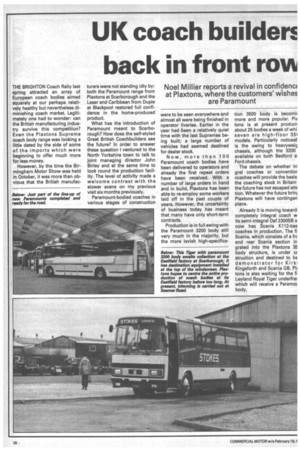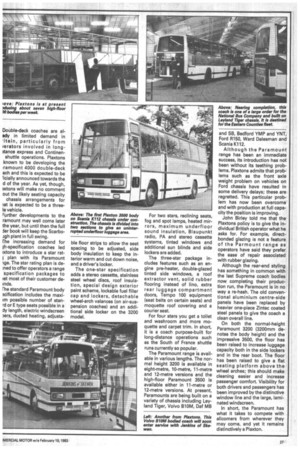UK coach builder back in front rovt
Page 28

Page 29

If you've noticed an error in this article please click here to report it so we can fix it.
Noel Millier reports a revival in confidenc( at Plaxtons, where the customers' wishes are Paramount
THE BRIGHTON Coach Rally last spring attracted an array of European coach bodies aimed squarely at our perhaps relatively healthy but nevertheless diminishing coach market. Legitimately one had to wonder: can the British manufacturing industry survive this competition? Even the Plaxtons Supreme coach body range was looking a little dated by the side of some of the imports which were beginning to offer much more for less money.
However, by the time the Birmingham Motor Show was held in October, it was more than obvious that the British manufac turers were not standing idly by both the Paramount range from Plaxtons at Scarborough and the Laser and Caribbean from Duple at Blackpool restored full confidence in the home-produced product.
What has the introduction of Paramount meant to Scarborough? How does the self-styled Great British Coachbuilders see the future? In order to answer these question I ventured to the North Yorkshire town to talk to joint managing director John Birley and at the same time to look round the production facility. The level of activity made a welcome contrast with the slower scene on my previous visit six months previously.
Paramount-bodied coaches in various stages of construction were to be seen everywhere and almost all were being finished in operator liveries. Earlier in the year had been a relatively quiet time with the last Supremes being built; a large number of vehicles had seemed destined for dealer stock.
Now, more than 100 Paramount coach bodies have been delivered to operators and already the first repeat orders have been received. With a number of large orders in hand and in build, Plaxtons has been able to re-employ some workers laid off in the past couple of years. However, the uncertainty of business today has meant that many have only short-term contracts.
Production is in full swing with the Paramount 3200 body still very much in the majority, but the more lavish high-specifica tion 3500 body is becomil more and more popular. Pla tons is at present producii about 25 bodies a week of whi seven are high-floor 351 models. Particularly noticeat is the swing to heavyweig chassis, although the 3200 available on both Bedford al Ford chassis.
The debate on whether ml gral coaches or conventior coaches will provide the basis the coaching stock in Britain the future has not escaped atte tion. Whatever the future brini Plaxtons will have contingen plans.
Already it is moving toward; completely integral coach w its semi-integral Daf 2300SB a now has Scania K112-bas coaches in production. The fi Scania, which consists of a frc and rear Scania section in grated into the Plaxtons 35 body structure, is under cc struction and destined to be demonstrator for Kirkl Kingsforth and Scania GB. tons is also waiting for the fi Leyland Royal Tiger underfrar which will receive a Paramot body,
Double-deck coaches are alsdy in limited demand in .itain, particularly from erators involved in longMince express and Continenshuttle operations. Plaxtons known to be developing the 'remount 4000 double-deck ach and this is expected to be icially announced towards the d of the year. As yet, though, Ixtons will make no comment out the likely seating capacity chassis arrangements for at is expected to be a threele vehicle.
Further developments to the remount may well come later the year, but until then the full der book will keep the ScarboJgh plant in full swing.
Ihe increasing demand for 0-specification coaches led ixtons to introduce a star rat, plan with its Paramount IgcL The star rating plan is dened to offer operators a range specification packages to Pet most of their customer deInds.
rhe standard Paramount body .1cification includes the maxim possible number of stenrd or E type seats possible in a dy length, electric windscreen mrs, ducted heating, adjusta ble floor strips to allow the seat spacing to be adjusted, side body insulation to keep the interior warm and cut down noise, and a driver's locker.
The one-star specification adds a stereo cassette, stainless steel wheel discs, roof insulation, special design exterior paint scheme, lockable fuel filler cap and lockers, detachable wheel-arch valances (on air-suspension coaches) and an additional side locker on the 3200 model. For two stars, reclining seats, fog and spot lamps, heated mirrors, maximum underfloor sound insulation, Blaupunkt radio, PA and stereo cassette systems, tinted windows and additional sun blinds and side lockers are added.
The three-star package includes features such as an engine pre-heater, double-glazed tinted side windows, a roof extractor vent, solid rubber flooring instead of lino, extra rear luggage compartment doors, Tempo 100 equipment (seat belts on certain seats) and moquette roof covering and a courier seat.
For four stars you get a toilet and washroom and more moquette and carpet trim. In short, it is a coach purpose-built for long-distance operations such as the South of France shuttle runs currently so popular.
The Paramount range is available in various lengths. The normal height 3200 is available in eight-metre, 10-metre, 11-metre and 12-metre versions and the high-floor Paramount 3500 is available either in 11-metre or 12-metre versions. At present, Paramounts are being built on a variety of chassis including Leyland Tiger, Volvo B10M, Daf MB and SB, Bedford YMP and YNT, Ford R150, Ward Dalesman and Scania K112.
Although the Paramount range has been an immediate success, its introduction has not been without its teething problems. Plaxtons admits that problems such as the front axle weight problem on vehicles on Ford chassis have resulted in some delivery delays; these are regretted. This particular problem has now been overcome and with production at full capacity the position is improving.
John Birley told me that the Plaxtons policy is to give the individual British operator what he asks for. For example, directbonded glazing is not a feature of the Parmount range as operators have said they prefer the ease of repair associated with rubber glazing.
Although the rear-end styling has something in common with the last Supreme coach bodies now completing their production run, the Paramount is in no way a re-hash. The old conventional aluminium centre-side panels have been replaced by heavier one-piece Zintec coated steel panels to give the coach a clean overall line.
On both the normal-height Paramount 3200 (3200mm de notes the body height) and the impressive 3500, the floor has been raised to increase luggage capacity both in the side lockers and in the rear boot. The floor has been raised to give a flat seating platform above the wheel arches; this should make cleaning easier and increase passenger comfort. Visibility for both drivers and passengers has been improved by the distinctive window line and the large, laminated windscreen.
In short, the Paramount has what it takes to compete with allcomers from wherever they may come, and yet it remains distinctively a Plaxton.








































































































